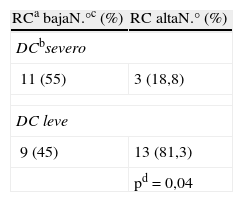Estudiar la relación entre reserva cognitiva (RC) y déficit cognitivo (DC) en los pacientes que han sufrido un accidente vascular cerebral.
DiseñoEstudio descriptivo transversal sobre 103 pacientes que sufrieron un ictus entre el 01-10-2010 y el 29-02-2012.
Material y métodoSe incluyen pacientes con más de un mes de evolución. Se excluyen los pacientes afásicos, los que presentan enfermedad mental previa y los exitus. Se evalúa en 36 pacientes la RC mediante el cuestionario de reserva cognitiva; el DC con el Mini-Mental State Examination (MMSE); el tipo de ictus según la clasificación del Oxfordshire Community Stroke Project (OCSP); la gravedad inicial mediante la escala del National Institute of Health Stroke Scale (NIHSS); la edad; el tiempo de evolución; el sexo; la etiología; el lado afectado por el ictus; el nivel cultural y la capacidad funcional medida con el índice de Barthel.
Se emplea la t de Student y la Chi-cuadrado según la variable y pruebas no paramétricas si la distribución no es normal (Kolmogorov-Smirnov). Se utiliza la regresión lineal y logística para cuantificar la relación y determinar el odds ratio (IC al 95%). Se considera p<0,05.
ResultadosLa RC media es de 9 (DE:5,4) puntos y el MMSE de 25,9 (DE:4,9) puntos. El 55,6% tienen RC baja y el 38,9% un DC severo. Existe relación lineal entre RC y MMSE (R=0,65; p<0,0001). Al ajustar por variables, el modelo que incluye la NIHSS y la edad, disminuye el MMSE 0,34 (IC 95%:0,61-0,07) y en 0,13 (IC 95%:0,25-0,004) respectivamente por unidad y explica el 53,5% del DC. Los pacientes con RC alta presentan un DC leve. El riesgo de DC severo lo determina una RC baja (OR:5,3; IC 95%:1,1-24,5) y mayor edad.
ConclusiónExiste relación entre RC y DC. Tener DC severo es 5 veces mayor cuando la RC es baja y aumenta en 1,1 por año de edad.
To study the relationship between cognitive reserve (CR) and cognitive deficit (CD) in patients who have suffered a stroke.
DesignA cross-sectional study was conducted on 103 patients who suffered a stroke between 10/01/2010 and 29/02/2012.
Material and methodsThe study included patients with more than one month's evolution. Patients excluded were aphasic patients, those with previous mental illness and patient's who died. The following were evaluated in 36 patients: CR using the Cognitive Reserve Questionnaire, CD Mini-Mental State Examination (MMSE), type of stroke according to the Oxfordshire Community Stroke Project classification, initial severity level by the National Institute of Health Stroke Scale (NIHSS), age, evolution time, sex, etiology, and side affected by stroke, cultural level and functional capacity measured with Barthel index. The Student's t test and chi-square test were used according to the variable and the non-parametric test if the distribution was not normal (Kolmogorov-Smirnov). Linear and logistic regression were used to quantify the relation and to determine the odds ratio (95% CI). A P<.05 was considered.
ResultsAverage CR 9 (SD: 5.4) was 9 points and MMSE 25.9 (SD: 4.9) points. Low CR was found in 55.6% and 38.9% had severe CD. There was a linear relation between CR and MMSE (R=0.65, P<.0001). After adjusting for variables, the model including NIHSS and age, MMSE decreased 0.34 (95% CI: 0.61-0.07) and 0.13 (95% CI: 0.25-0.004), respectively, per unit and accounts for 53.5% of CD. Patient with high CR had mild CD. The risk of severe CD is determined by low CR (OR: 5.3; 95% CI: 1.1-24.5) and older age.
ConclusionThere is relationship between CR and CD. The presence of severe CD is 5 times higher when the CR is low and increases 1.1 per year of age.
Artículo
Comprando el artículo el PDF del mismo podrá ser descargado
Precio 19,34 €
Comprar ahora












